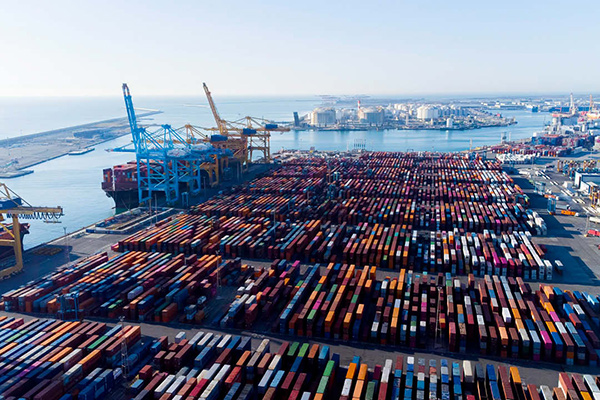Discover how manufacturing leaders can navigate tariff risks and build resilient, adaptive supply chains for long-term success.

By Lou Longo, Partner, International Consulting Practice, Plante Moran
Few manufacturing organizations remain untouched by the current tariff landscape. Some assessments suggest manufacturing as a whole faces the highest risk exposure to tariffs, with a recent report by the JPMorganChase Institute specifying that mid-sized businesses may feel the most significant tariff impacts.
With so much at stake, many business and supply chain leaders are doing one of two things:
There is, however, a third option that organizations can pursue: seize the opportunity to rethink the global supply chain.
This is not a time to hesitate or merely react to the latest headlines. Instead, organizations should commit to understanding their differentiators, analyzing their tariff exposure, and positioning themselves to act with clarity. For companies focused on long-term growth and stability, this is the ideal time to consider a new, “one-size-fits-one” strategy to mitigate supply chain risk.
Manufacturing trends have long shaped companies’ global footprints in ways that can be described as “one-size-fits-all,” “one-size-fits-many,” and “one-size-fits-one.”
The “fits-one” strategy requires companies to evaluate the unique risks and opportunities within their own portfolios. In practice, this often results in a regionalized approach to the supply chain, which makes it easier for organizations to customize and provides multiple levers to pull when needed. A tariff on supplies imported to the US from China, for example, would only impact a portion of the company’s overall goods, and might be mitigated by leveraging supply relationships and capacity in other regions.
Admittedly, implementing the “fits-one” approach may be more expensive and can introduce inefficiencies in the short term, since it adds duplicative productive capacity across multiple locations. In exchange, though, organizations gain diversification that reduces downside risk.
“Fits-one” lowers risk exposure by providing easier options to pivot when one (or more) geographies experience supply chain turbulence. It vastly reduces the hidden cost of the risk inherent to the “fits-all” and even “fits-many” strategies.
Think of it much like a retirement account portfolio. A diversified portfolio may not consistently result in the highest returns, but it’s much less susceptible to massive swings and will likely achieve better results over the long term.
Make no mistake: relocating a supply chain is challenging and involves upfront expenses. Consequently, any decision to migrate to a “fits-one” approach must be grounded in a thorough assessment of each organization’s unique goals, products, and risk exposure. But with the proper analysis, new strategic opportunities may arise.
To begin the analysis, organizations that aren’t doing so already must start to:
With this data in hand, organizations should then conduct a three-step process to move toward a “fits-one” strategy:
Finally, armed with all of these insights and information, organizations must take a critical look at where they want to go strategically. Are they trying to maximize short-term returns or optimize for the longer term? If the answer is the latter, then it may be the right time to adjust the company’s supply chain and production philosophy to a “fits-one” regionalization strategy.
Adopting a new philosophy about something as complex as the supply chain is never easy, but that doesn’t mean it’s not worth doing.
Remember when the International Organization for Standardization (ISO) 9000 series of quality management standards first emerged in the late 1980s? Many organizations believed it would do nothing more than add unnecessary hassle and cost. Over time, however, they came to recognize that implementing ISO 9000 could actually help them improve quality, lower costs, and seize a strategic product advantage.
Today, global supply chains are no longer shaped by uniform decisions. Adopting a regional, “fits-one” supply chain strategy may not be simple. But just as with ISO 9000, organizations must keep the endgame in mind. Embracing the shifting tariff environment as an opportunity to rethink the supply chain can create a more effective path to long-term growth and stability.
About the Author:
Lou Longo is a Partner and the leader of the International Consulting Practice at Plante Moran. For over three decades, he has helped clients increase their operational efficiency and grow their businesses across borders. He is a frequent speaker on globalization and enjoys assisting organizations in achieving the highest profitability and quality in their international operations.
Read more from the author:
Navigating tariff changes: A guide to protecting margins. | CFO.com. Published April 2, 2025.
6 Questions With…Plante Moran’s Lou Longo. | Supply Chain Management Review. Published June 24, 2025.
In this episode, I sat down with Beejan Giga, Director | Partner and Caleb Emerson, Senior Results Manager at Carpedia International. We discussed the insights behind their recent Industry Today article, “Thinking Three Moves Ahead” and together we explored how manufacturers can plan more strategically, align with their suppliers, and build the operational discipline needed to support intentional, sustainable growth. It was a conversation packed with practical perspectives on navigating a fast-changing industry landscape.